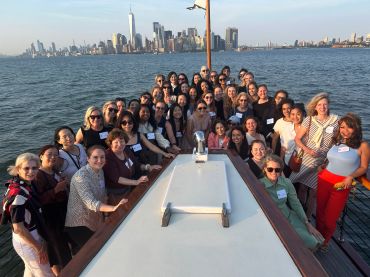Fore Sale! Suddenly Golf Seems More of an Asset Class Than Ever
Credit the prospect of four-day workweeks and the expansion of off-course options like Topgolf
By Anna Staropoli June 12, 2024 9:00 am
reprints
Near the San Juan Mountains, Colorado’s Cornerstone Club pairs a tranquil lake, four pickleball courts and a residential community with a 7,800-yard golf course, a quality-of-life asset that’s experienced an upswing since the pandemic.
“People want to live on a golf course,” said Keith Poliakoff, a managing partner at Government Law Group, who works with redesigned golf courses, primarily in Florida. “It becomes the focal point of a community and a way of life.”
When the housing market crashed circa 2008, fewer people had disposable income to prioritize golf. Once COVID hit, however, “suddenly everybody was a golfer,” said Jan Freitag, national director of hospitality analytics at CoStar Group. “The pandemic was all about being outdoors and being physically separated.”
Last year, some 123 million people participated in golf, whether by playing it, listening to a related podcast, or reading about or watching the sport, according to the National Golf Foundation (NGF). That’s 30 percent more Americans involved with golf than in 2016. On the infrastructure side, the United States finished 2023 with roughly 16,000 golf courses across 14,000 golf facilities. (These facility statistics are consistent with previous years, even before the pandemic; the golf industry focuses more on redevelopment than new development.)
Such demand caught the attention of hedge fund billionaire and New York Mets owner Steve Cohen, who, alongside other investors, plans to invest up to $3 billion in PGA Tour Enterprises, the PGA Tour’s for-profit entity. Cohen rationalized the investment with the prospect of a four-day workweek, which would increase leisure time. (Since that prediction earlier this spring, however, federal regulators outlined reporting requirements that may bring many bankers at least into the office five days a week.)
Yet golf’s successes may have less to do with a potential four-day workweek than with the wider evolution of today’s post-pandemic workplace. COVID increased the demand for outdoor spaces while normalizing hybrid or remote-work models. Consequently, people of all ages funneled more free time into golf, and embraced nontraditional, informal iterations of the sport.
As golf demand continues to surge, associated developments are broadening the sport’s potential, leveraging golf for other real estate opportunities. In recent years, developers have increasingly funneled investments into golf-adjacent hospitality and residential assets, charting the literal and figurative course for golf courses of the future.
Work from home largely explains why golf has stuck around since the pandemic, said Matt Dusenberry, principal at Dusenberry Golf Course Design, which helped design Colorado’s Cornerstone Club. If someone’s working from home, they can fit in a game before or after work, even if they’re working every day.
Florida — one of the country’s top golf states — had lenient lockdown restrictions, calling attention to golf in the early stages of the pandemic. “Golf was kept open, and it really created a massive boom to the hobby, to the sport,” said Cameron Kimball, a Florida resident and vice president of sales at the Residences at St. Regis Los Cabos at Quivira, a 33-acre property that includes Mexico’s Quivira Golf Club, 74 residences and a 120-room hotel.
Flexible work schedules particularly appeal to millennials and young adults between 18 and 34, some of whom know no other way of working. They have emerged as golf’s top customer bracket, per the NGF. (Engagement with young adults has been steady over the last 10 years, though the demographic may be priced out of traditional golf courses and clubs. Kimball’s residences range from $4.6 to $12 million, with a target demographic aged 40 to 65.)
It’s the younger golfers who may be steering the sport away from its formalities — and opening the door for newer golf assets. “Whether it’s at a private club or a resort, probably the highest growth [in new golf development] is in what we call nontraditional golf,” said Dusenberry.
Perhaps nothing better exemplifies this shift than the rise in Topgolf and similar off-course developments that require neither the space or time nor the formalities of traditional golf courses. Instead, they leverage the sport as a medium of entertainment and, without a need for a large swath of land, allow development closer to city centers.
In 2023, roughly 26.6 million Americans over the age of 5 exclusively played golf on courses, but another 18.4 million participated exclusively in off-course variants like Topgolf, driving ranges and golf simulators, according to the NGF. Of those Americans, 6.3 million young adults played golf on a course, while 5.8 million stayed off-course.
Real estate reflects these statistics. In 2022, the Empire State Building announced plans to build a golf simulator, while the developers of Huntsville, Ala.’s MidCity prioritized building Topgolf, which is currently open even as the rest of the 140-acre development is still under construction. In Colorado, Cornerstone Club — designed in part by Dusenberry — invested in an indoor-outdoor bar space, presenting golf as just one aspect of a larger leisure ecosystem. In fact, Government Law Group’s Poliakoff would guess that Topgolf makes more money on alcohol and food than it does on its namesake sport.
Such attention to golf-adjacent amenities hints at the sport’s fundamental real estate opportunity: increasing the value of surrounding hotels and residences. On its own, golf inefficiently uses land, and redeveloping a course can cost anywhere from a few million dollars to tens of millions. Even if a property charges $100 a round, it’s unlikely to recoup the investment, said Poliakoff.
“The developer has to take land into consideration and the cost of not doing residential on that land,” said Kimball. “You can sell houses around that golf course and thereby increase the value of the land and/or product around the golf course. But if you didn’t build the golf course at all, would you actually be able to sell the land for more?”
To maximize profit, golf courses sustain themselves with complementary components, like hotel rooms. Take the golf course at Puerto Rico’s St. Regis Bahia Beach, which in 2021 recorded its most golf rounds played since the hotel’s 2009 opening. “Every year after that we have seen an increase in rounds of 4 to 5 percent,” Alberto Rios, the hotel’s head of golf operations, told Commercial Observer via email. “In the last two years, golf group activity has also increased by 15 to 20 percent.”
The Residences at St. Regis Los Cabos at Quivira focuses not only on hospitality but also on residential, using golf to drive up a residence’s unit price per square foot, said Kimball, the project’s vice president of sales. Even non-golfers reselling or renting a property want to avoid missing out on a valuable market segment, he said, and without a golf course, a development may lose customers to similarly priced competitors. Hotels or residences also draw a steady clientele to the golf course, so there’s more security that golfers will actually come to play.
Golf has the potential to not only increase property value but to also mitigate the effects of climate change … though the sport uses its fair share of water. (On average, golf courses across the United States use a total of 1.5 billion gallons a day, according to the United States Golf Association.)
Despite golf’s impact on the climate, water remains on the mind for golf developers as they redevelop courses. Clubs’ most costly infrastructure expense is typically irrigation, Dusenberry said, “and we know probably the long-term threat of golf in these arid regions is water use.”
Water use, as well as fertilizer, is likely to be increasingly scrutinized through future regulation, so Dusenberry is already considering these factors in his designs. Developers likewise need to be mindful to plan their courses around accessibility to water, said CoStar’s Freitag.
“Golf courses now are also seen as the central drainage feature for many communities,” said Poliakoff. “So, when the golf courses are being redeveloped, we are being asked by local governments to redesign the courses to almost look now like Northern courses.” For example, South Florida courses have traditionally been flat, but redesigns include drainage features that turn the courses into temporary reservoirs that can hold stormwater runoff.
Golf’s adaptability to both environmental and work-from-home climates bodes well for the sport’s future, though golf still, largely, requires time and money. As more people return to the office, Freitag said the financial question is: “Is it wise for resorts, as they develop amenities, to invest in that infrastructure?”
For now, the answer seems to be yes, with golf’s demand stronger than its current supply. Dusenberry likened golf to housing: There’s been a sustained period of time without new construction, with tee sheets full and club waiting lists long. Renovations occupy about 80 percent of golf design and construction work, while new construction warrants about 20 percent. Five years ago, the percent ratio would’ve been even starker at 95 to 5, he said.
However incremental, the increase reflects interest. “Knowing the expense [of redevelopment], if no one was playing, there’s no way they would spend the money doing it,” said Poliakoff.
Anna Staropoli can be reached at astaropoli@commercialobserver.com.


